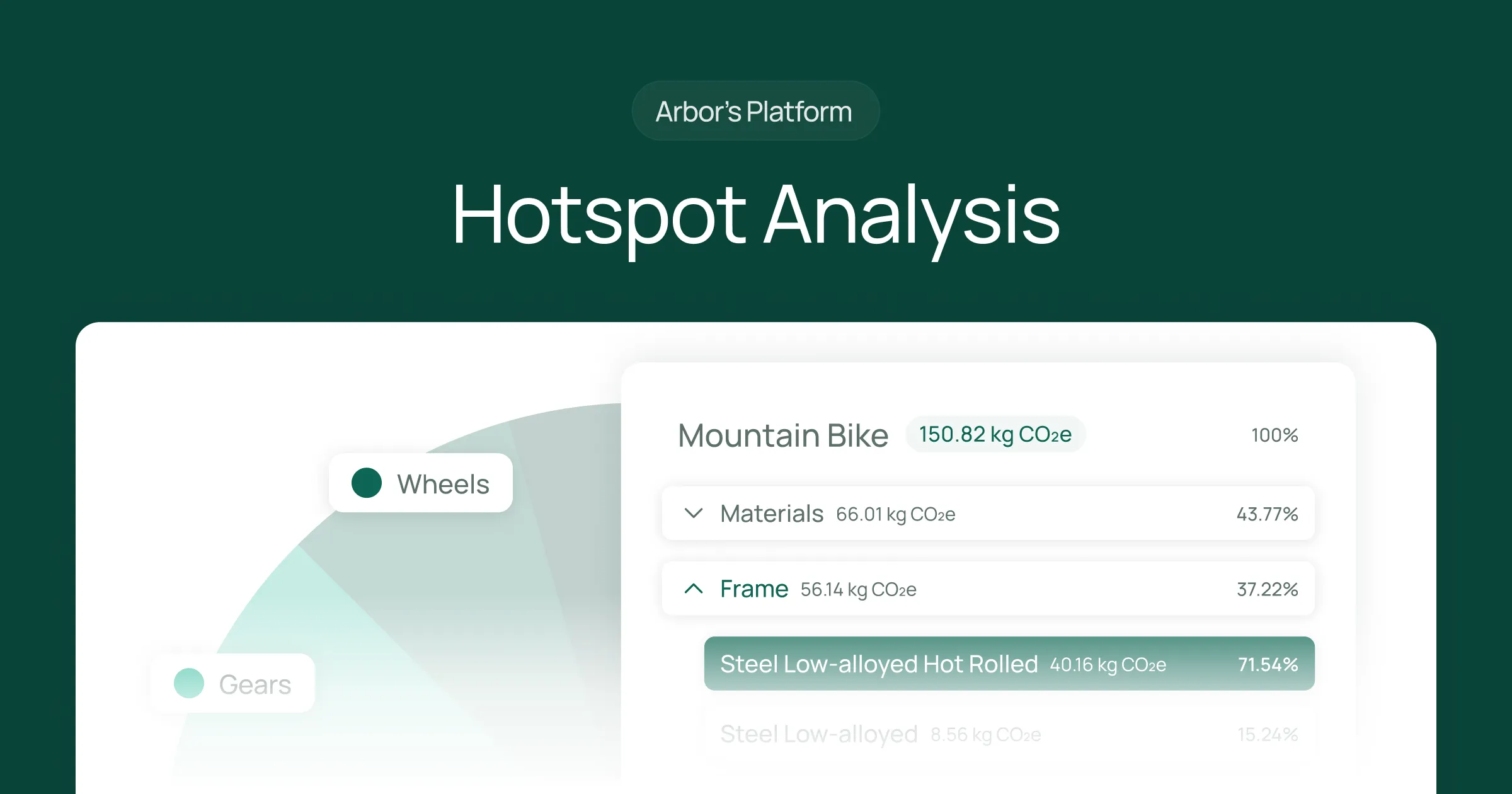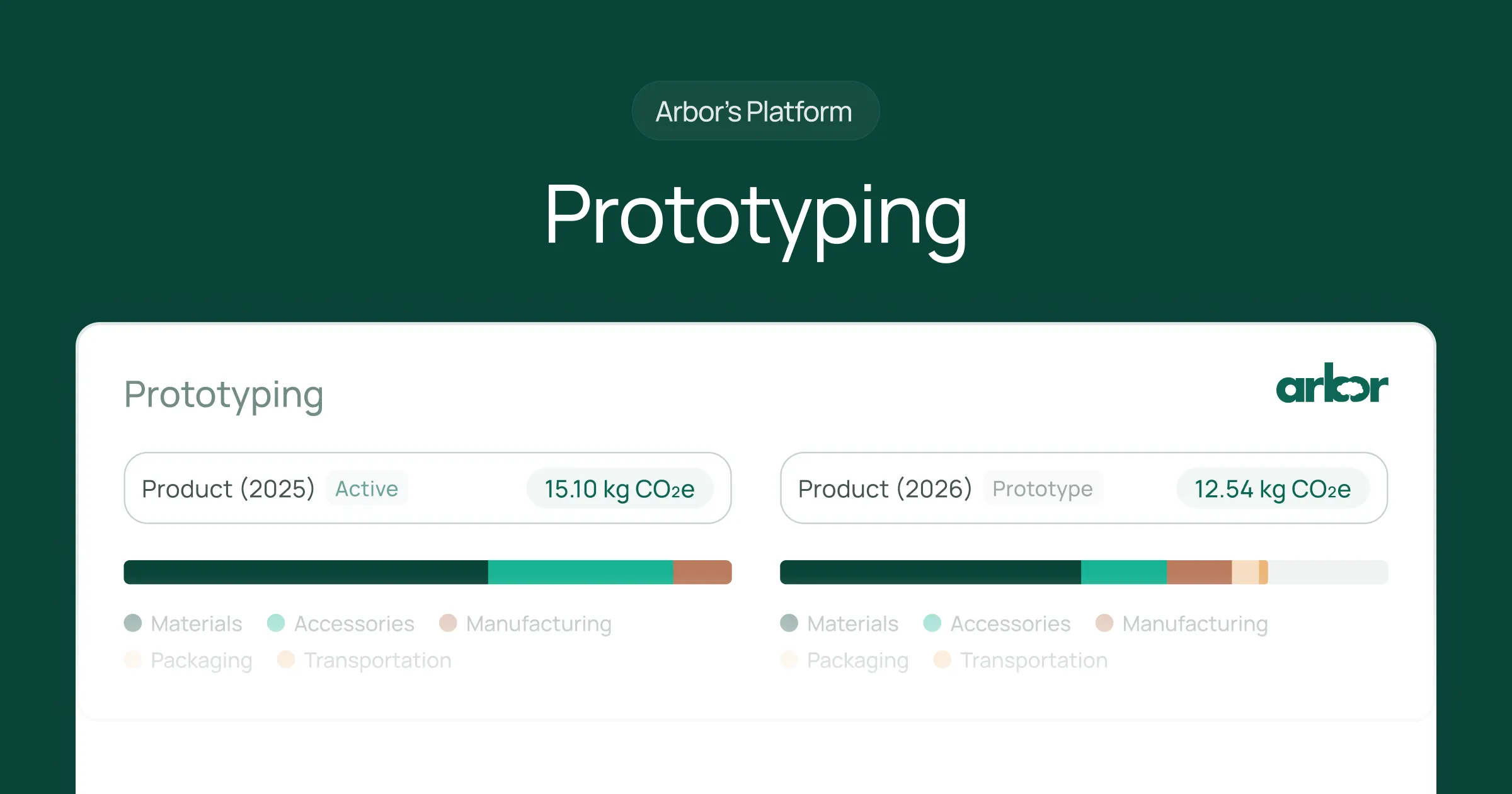Understanding the carbon footprint of a product is more crucial than ever. At Arbor, we recognize that knowledge is a key driver for fostering sustainable practices. The term "carbon footprint of a product" encapsulates the total greenhouse gas (GHG) emissions generated throughout a product’s lifecycle—from raw material extraction to disposal.
By diving deeper into this concept, businesses can make more informed choices and contribute to a healthier planet. Join us as we unravel the complexities of the carbon footprint of a product and explore how conscious decisions can drive meaningful change.
What is the Carbon Footprint of a Product (CFP)?
The carbon footprint of a product is a metric that quantifies the total greenhouse gas emissions associated with a product throughout its lifecycle. This footprint is expressed in terms of carbon dioxide equivalents (CO₂e), which accounts for not only carbon dioxide (CO₂) but also other significant GHGs such as methane (CH₄) and nitrous oxide (N₂O), based on their global warming potential.
Lifecycle Stages of the Carbon Footprint of a Product
The carbon footprint of a product encompasses all stages of a product's lifespan, often referred to as a "cradle to grave" analysis. These stages include:

Raw Material Extraction
Raw material extraction represents a crucial phase in a product’s lifecycle where considerable carbon emissions occur. This stage involves harvesting natural resources such as mining metals—processes that are typically energy-intensive and environmentally impactful. According to the carbon footprint methodology, the emissions from raw material extraction fall under Scope 3 emissions, critical for comprehensive carbon accounting.
Manufacturing & Processing
Transitioning from raw materials to finished products requires substantial energy, often resulting in significant carbon emissions. Manufacturing efficiency and technological innovations can greatly influence this stage’s carbon footprint, emphasizing the importance of sustainable production practices.
Transportation & Distribution
Transporting raw materials to manufacturing sites and delivering finished goods to consumers contribute significantly to a product’s carbon footprint. Logistics optimization, such as adopting greener transportation methods and improving supply chain efficiency, can mitigate these emissions.
Use Phase
The use-phase footprint varies dramatically depending on the product. For example, an electronic device's carbon footprint includes the electricity consumed during its operational life, while non-electronic items have different considerations. Prioritizing energy efficiency and durability can reduce the carbon impact during this stage.
End-of-Life
End-of-life emissions stem from the disposal or recycling of products. Sustainable design, including recyclability and material reuse, is crucial for minimizing the environmental impact at this stage. Effective waste management practices can significantly lower the carbon footprint associated with product disposal.
Only the stages of raw material extraction and up until manufacturing fall under the “cradle to gate” analysis method.
Why is Understanding the Carbon Footprint of a Product Important?
Understanding the carbon footprint of a product is critical for companies aiming to reduce their environmental impact and meet both regulatory requirements and growing consumer demand for sustainable products. Here are several key benefits of assessing the carbon footprint of a product:
Regulatory Compliance
The carbon footprint assessments are integral to Scope 1, 2, and 3 emissions reporting. Accurate assessments are necessary for setting and meeting Scope 3 reduction targets, covering indirect emissions from the entire value chain. For further details, the authoritative guidelines on Scope 3 Emissions provide a robust framework.
Supply Chain Optimization
By identifying emission "hotspots" within the supply chain, companies can focus their decarbonization efforts on where they will have the greatest impact. Product Carbon Footprints help retailers address the 80-98% of their emissions that come from Scope 3, primarily from purchased goods and services. A small reduction of just 3-5% in PCF can often result in more emissions savings than reducing 50-100% of their Scope 1 and 2 emissions combined, highlighting the massive impact of addressing Scope 3.
Consumer Engagement
Modern consumers are increasingly environmentally conscious. Providing transparent data on the carbon footprint of a product can build brand loyalty and enhance market competitiveness by meeting the expectations of these eco-aware consumers. Studies show that products with lower carbon footprints are gaining preference among consumers, making transparency in carbon footprint a vital component of sustainable business practices.
Employing assessments on the carbon footprint of products allows businesses to understand and mitigate their environmental impact.
Reducing the Carbon Footprint of Your Products: Practical Steps
Conduct Comprehensive Assessments
Begin by thoroughly understanding the carbon footprint of your products. Utilize tools and methodologies like Life Cycle Assement (LCA) to identify major emission sources and areas for improvement.
Implement Sustainable Practices in Manufacturing
Adopt energy-efficient technologies, minimize waste, and optimize resource usage within manufacturing processes to lower emissions. Focus on reducing energy consumption and increasing the use of renewable energy sources.
Optimize Your Supply Chain
Identify and address emission hotspots within your supply chain. Collaborate with suppliers to enhance sustainability practices and reduce overall carbon emissions.
Innovate with Eco-friendly Designs
Develop products that are energy-efficient, durable, and recyclable. Sustainable design strategies can significantly reduce the total carbon footprint from raw material extraction to end-of-life disposal.
Engage Consumers with Transparency
Clearly communicate your product’s carbon footprint and your commitment to sustainability. Transparency not only builds trust but also aligns with the growing consumer demand for eco-friendly products.
Summary
Understanding and reducing the carbon footprint of your products is not just an environmental responsibility but also a competitive advantage. Comprehensive assessments provide invaluable insights, enabling you to make informed decisions and take strategic actions that align with sustainability goals. By integrating sustainable practices, optimizing supply chains, and innovating product designs, you can significantly reduce your carbon footprint, ensuring regulatory compliance and meeting the expectations of eco-aware consumers.
Ready to take the first step towards reducing your product carbon footprint?
Discover how Arbor can help you measure, analyze, and reduce your product's carbon emissions.
Request a demo today.
Measure your carbon emissions with Arbor
Simple, easy carbon accounting.

FAQ About Carbon Footprint of Products (CFP)
What's the difference between a Product Carbon Footprint (PCF) and a Carbon Footprint of a Product (CFP)?
The terms Product Carbon Footprint (PCF) and Carbon Footprint of a Product (CFP) are interchangeable, both referring to the total greenhouse gas emissions associated with a product's entire life cycle. This measurement includes emissions from raw material extraction, manufacturing, transportation, use, and disposal, typically expressed in carbon dioxide equivalent (CO2e). PCF or CFP is calculated using life cycle assessment methodology and serves as a crucial tool for companies to understand and reduce their products' environmental impact.
What does the carbon footprint of a product include?
The carbon footprint of a product includes all greenhouse gas emissions generated throughout its lifecycle, from raw material extraction to manufacturing, transportation, usage, and disposal.
How is the carbon footprint of a product measured?
The carbon footprint is measured in carbon dioxide equivalents (CO₂e), considering various greenhouse gases like methane and nitrous oxide based on their global warming potential.
Why is the carbon footprint of a product important for businesses?
Understanding the carbon footprint helps businesses reduce their environmental impact, comply with regulations, optimize supply chains, and meet consumer demand for sustainable products.
What is the difference between "cradle-to-grave" and "cradle-to-gate" assessments?
"Cradle-to-grave" assessments cover the entire lifecycle of a product from raw material extraction to disposal, while "cradle-to-gate" assessments only cover up to the manufacturing stage.
How can businesses reduce the carbon footprint of their products?
Businesses can reduce their carbon footprint by adopting sustainable manufacturing practices, optimizing logistics, using eco-friendly materials, and designing products for durability and recyclability.
What role does consumer behaviour play in the carbon footprint of a product?
Consumer behaviour impacts the use-phase emissions of a product. Selecting energy-efficient products and properly disposing of them can help reduce the overall carbon footprint.
How does the carbon footprint of a product affect regulatory compliance?
Accurate carbon footprint assessments are necessary for meeting regulatory requirements, such as reporting Scope 3 emissions, which include indirect emissions from the entire value chain.
What are some tools for calculating the carbon footprint of a product?
Tools like Life Cycle Assessment (LCA) software, like Arbor’s carbon accounting platform, ISO 14067 standards, and the GHG Protocol, provide methodologies and guidelines for accurately calculating a product's carbon footprint.
How does reducing the carbon footprint benefit a company's bottom line?
Reducing the carbon footprint can lead to cost savings through improved energy efficiency, waste reduction, and optimized resource usage. It can also enhance brand reputation and customer loyalty.
What are Scope 3 emissions, and why are they important?
Scope 3 emissions are indirect emissions from all activities in a company's value chain, such as raw materials extraction and product disposal. They are crucial for comprehensive carbon accounting.
How can transparency in carbon footprint reporting build consumer trust?
Providing transparent carbon footprint data can align with consumer values, building trust and loyalty among eco-conscious customers who prefer sustainable products.
What impact does end-of-life disposal have on a product's carbon footprint?
End-of-life disposal, including recycling and waste management, contributes to a product's total carbon footprint. Efficient waste management practices can significantly reduce these emissions.


.avif)
.webp)
%20Directive.webp)


.webp)











%20Arbor.avif)





%20Arbor.avif)


.avif)






%20Arbor%20Canada.avif)

.avif)
%20Arbor.avif)
.avif)






_.avif)
.avif)
%20Arbor.avif)




%20Software%20and%20Tools.avif)





.avif)




%20EU%20Regulation.avif)












.avif)


%20Arbor.avif)









_%20_%20Carbon%20101.avif)







.avif)

.avif)
.avif)









